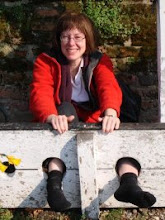The papers presented were:
Chris Burgess - West Kent Textiles in Wills, Inventories and Probate 1550-1650.
Celia Eddy - The Ogier Wedding Quilt - North American Influence in British Quilts from the Mid Nineteenth to early Twentieth Century.
Ann Gibson - Patchwork - A Literary Tale (Patchwork in childrens' books)
Anne Jeater - A Tyneside Signature Quilt - A Passport to a Primitive Methodist Community in the 1890's?
Lynne Setterington - Signature Quilts Old and New
Laurel Horton and Erin Beeston - Boltons Cotton Counterpanes - Handweaving in the Industrial Age
The Signature Quilt that Anne Jeater was speaking about belongs to the Quilters Guild, and we were lucky enough to be able to see the quilt. A large portrait of Queen Victoria is found in the centre of the quilt.
The quilt came from Tyneside, so it nicely quilted in North Country motifs.
Anne was able to go to the Primitive Methodist archives, and found a note in the meeting minutes to the effect that the proceeds had been used to buy a new carpet and curtains. By measuring the area that had been carpeted, and using approximate carpet prices of the era, she was able to arrive at a figure for the earnings of the signature quilt. I shall now have to go and look at my quilt more carefully - of course my quilt is Wesleyan, not Primitive, Methodist. I don't know if my quilt was used as a fundraiser.
I shall also push ahead this year with my Sanderson Star paper and hope to finish it for next year. Our exhibition at York (Quilt Museum) is next Autumn and we are devoting a lot of energy as a group to the exhibition and the seminar which will also be in York. This is the time to use some of the reserves that have accumulated and to produce a small but scholarly exhibition catalog.






Sounds like a great line up of topics for your seminar. I'll be traveling in England 2013 when your exhibit is on in York. I've started bookmarking places/events to plan my trip.
ReplyDelete